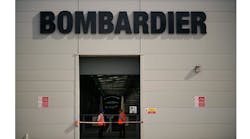Bombardier Inc. plans to cut about 5,000 jobs while selling its turboprop unit and a training business as Chief Executive Officer Alain Bellemare extends a far-reaching turnaround drive at the debt-laded Canadian aerospace company.
Net proceeds from the asset sales will be about $900 million, Bombardier said in a statement Thursday. The employment reduction, Bellemare’s third since taking the reins in 2015, will yield annual savings of about $250 million by 2021. The cut represents more than 7% of the company’s workforce.
Bombardier is working off $9.5 billion in adjusted debt, which was largely incurred as the manufacturer poured money into two aircraft-development programs plagued with delays and cost overruns. The Global 7500 private jet is set to debut next month, marking the end of the company’s heavy investment cycle. Bombardier ceded control of the C Series passenger plane in July to Airbus SE, which renamed it the A220.
“The company is moving toward the final deleveraging stage of its strategy and efforts announced today are encouraging,” Walter Spracklin, an RBC Capital Markets analyst, said in a note to clients.
But Bombardier also stepped back from its 2018 cash-flow goal, citing an “intense delivery phase” in its rail business. Its target to break even on a cash-flow basis, plus or minus $150 million, now includes the $635 million Bombardier got from a land sale in Toronto. The previous target excluded those proceeds.
“Investors won’t like the big chop to cash flow guide, which raises questions regarding management credibility and ability to complete a successful turnaround,” Cai von Rumohr, an analyst at Cowen & Co., said in a note to clients.
Bombardier’s widely traded Class B shares gained 5.3% this year through Wednesday. This compares with the 5.6% advance of industrial companies on Canada’s benchmark S&P/TSX Composite Index.
Bombardier will sell its Q Series turboprop program and de Havilland trademark to a subsidiary of Canada’s Longview Aviation Capital Corp., parent company of Viking Air Ltd., which makes the Twin Otter propeller plane. CAE Inc. will buy Bombardier’s business-jet flight and technical training activities.
More Moves Likely
Bellemare probably isn’t done remaking Bombardier. The company said it will “explore strategic options” for its CRJ regional-jet program. The focus for now is on reducing cost and increasing volumes while optimizing aftermarket revenue for about 1,500 CRJs in service.
The moves hasten a future in which growth will revolve around private jets and trains. Together, those two businesses accounted for about 88 percent of third-quarter sales.
Bombardier’s liquidity boost from the asset sales should bring the company closer to reacquiring a minority stake in its rail business from the Caisse de Depot et Placement du Quebec, Spracklin said. The company is assessing buyback options for the stake, Bombardier Chief Financial Officer John Di Bert said on a conference call with analysts.
With the aerospace investment effort complete, key engineering team members will be redeployed. The largest group will move to the private-plane operation “to ensure they have all the necessary capabilities for future business jet development programs,” Bombardier said.
Financial Outlook
The Montreal-based manufacturer is counting on a 2019 sales boost after next month’s expected debut of the Global 7500, its largest business aircraft.
Revenue will increase about 10% to $18 billion in 2018, with earnings before interest, taxes and special items targeted to climb about 20% to as much as $1.25 billion, the company said. The job cuts are expected to result in a restructuring charge of about $250 million.
In the third quarter, adjusted earnings rose to 4 cents a share, topping the 2 cent average of analyst estimates compiled by Bloomberg. Sales fell 5.1% to $3.64 billion, compared with the average estimate of $3.87 billion. The company burned through $370 million of cash in the period, an improvement from the $495 million it used a year earlier.
Results in Bombardier’s regional aircraft business, which includes the Q400 turboprops and the CRJs, have traditionally lagged those of trains and business jets.
In the third quarter, the commercial aircraft business recorded a loss of $9 million before interest, taxes and special items. Profit in trains was $187 million, while business aircraft earned $89 million.
By Frederic Tomesco




